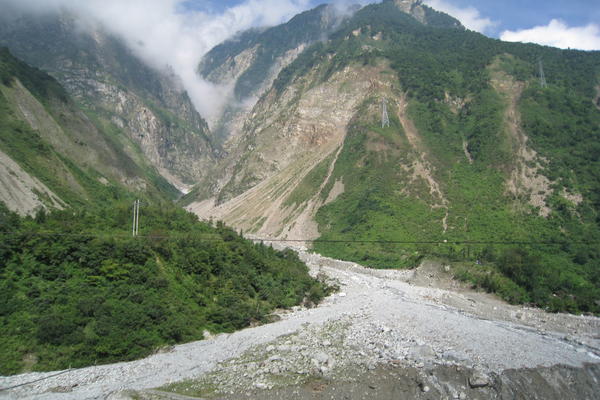Years after an earthquake, rivers still carry the mountains downstream

Landslides on the hillsides and sediment on the river valley sides at Longmen Shan, Sichuan China (Image credit: Professor Bob Hilton)
On 12th May 2008, the magnitude 7.9 Wenchuan Earthquake shook central China, its destructive tremors spreading from the flank of the Longmen Shan, or Dragon's Gate Mountains, along the eastern margin of the Tibetan Plateau. Over 69,000 people died in the disaster, nearly a third from geohazards like the more than 60,000 landslides that rushed down the slopes of the Longmen Shan. After a decade and a half of research, scientists finally have an account of the fate of the landslide debris. Surveys of a reservoir downstream of the epicentre revealed how and how quickly the region’s major river moved this sediment, as well as the effect it had on the river channel itself. The results, published today in the journal Nature and co-authored by Oxford Earth Sciences' Prof Bob Hilton, suggest that the hazards caused by megaquakes may last long after the ground has settled.
Shaking the mountains loose
The international research team used observations from after the Wenchuan Earthquake to investigate the fate of the vast quantities of rock and soil delivered to the region's streams and rivers (known as sediment flux). Previous case studies have revealed that this comes in two varieties: suspended sediment in the water column, and bedload in the form of coarse material - from gravels to boulders - rolling and bouncing along the river bottom.
Scientists find that suspended sediment flux increases after earthquakes, but this is only part of the picture, and the bedload remains relatively understudied.
“Before our work, people mostly focused on the sediment of very fine size” said first author Gen Li, an assistant professor in UC Santa Barbara’s Department of Earth Science. Measuring the flux of suspended sediment is relatively straightforward, involving collecting samples of the river water, and is a routine activity conducted by government agencies.
It's long been known that bedload carried by rivers after earthquakes can fill up river channels with sediment. Flooding often follows earthquakes, and scientists believe that this pulse of sediment freed by seismic activity is to blame, raising the riverbed so the river overflows from the shallower channel. Unfortunately, it has been very difficult to make direct measurements of this bedload flux.
A small stroke of luck amid a disaster
The Zipingpu Dam, which started construction in 2001 and began to impound the Min River by 2006, became the perfect sediment trap for the research team to investigate these questions. The reservoir, located 20 kilometres downstream of the Wenchuan Earthquake’s epicentre, collects sediment draining from the Longmen Mountains.
In collaboration with the Chinese Bureau of Hydrology, the researchers began surveying the sediment flowing into the reservoir. The agency monitored the suspended sediment flux each day, but the scientists needed data to characterize the river’s bedload. This seemingly straightforward task required an enormous effort spanning over a decade of field campaigns. The team spent days on a boat mapping the bottom of the reservoir with sonar. The changes from one field expedition to the next built up an account of how much total sediment had accumulated in the reservoir over time. It was then a simple matter of subtracting the suspended load flux from the total sediment flux to calculate the bedload flux.
Large results
The research team found that total sediment flux in the Min River grew sixfold after the Wenchuan Earthquake, but the more interesting result was that the bedload component increased by 20 times. This meant bedload accounted for roughly 65% of the overall sediment flowing through the river after the earthquake (typical values for mountain rivers of this size are generally around 20%).
But the team wasn’t interested only in the bedload flux. They also wanted to know how long it would take the Min River to clear the pulse of material liberated by the earthquake. The elevated flux persisted for at least ten years, up to the last field expedition the authors took before publishing their results. “In fact, from the data we’ve collected so far, there’s no evidence yet of the total sediment flux declining back to background levels” said co-author John West (University of Southern California).
“Usually, we think the influence from earthquakes may last, at most, a few years after the main shock, but this data shows that this is not true.”
- Gen Li (University of California Santa Barbara), lead author of the study
The long tail of geohazards
The findings have major implications for how we manage natural disasters; the cascade of hazards induced by a large earthquake can persist far longer than people may expect, possibly decades.
“Earthquake-triggered landslides are a great example” West said. “As we prepare for natural disasters, we often think of them as being discrete events, but what’s left out of that is the longer tail that follows”. Costs and actions are framed in terms of preparing for this event and dealing with its immediate aftermath.
For instance, it’s foolish to rebuild in the same way in the same place, the authors said. The risks aren’t merely as high as they were before; they’ve actually increased because the landscape has changed. A river full of sediment cannot accommodate the same 10-year flood it could have before. As a result, a growing group of researchers are now working together to tackle the grand challenge of cascading hazards from earthquakes.
“This work, led by Prof. Gen Li, is the cumulation of 15 years of collaborative research focused on the chronic, long-term geohazards that follow catastrophic earthquakes. We found that the amount of pebbles and sand carried at the river bed increased dramatically after the earthquake due to a large number of landslides in the mountains. This increased river sediment transfer has lasted for more than 10 years. The work helps to better understand the impacts on infrastructure and people’s lives long after the shaking stops”.
- Bob Hilton (Oxford Earth Sciences), study co-author
The study 'Large riverbed sediment flux sustained for a decade after an earthquake' is available to read in the journal Nature at https://doi.org/10.1038/s41586-025-09354-8. This article was adapted from an original news story authored by Harrison Tasoff and Shelly Leachman, published by the University of California Santa Barbara.




